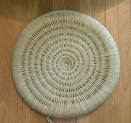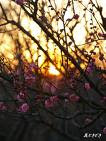:::::::::::::::::::::::::::::::::::::::::::::::::::::::::::::::::::::::::::::::::::::::::::::::::::::
Hemp (asa, ooasa) flax (ama)
***** Location: Japan
***** Season: Various, see below
***** Category: Plant, Humanity
*****************************
Explanation
Hemp (from Old English hænep) is the name of the soft, durable fibre that is cultivated from plants of the Cannabis genus, cultivated for industrial and commercial (non-drug) use.
In modern times, hemp has been used for industrial purposes including paper, textiles, biodegradable plastics, construction, health food, fuel, and medical purposes; with modest commercial success. In the past three years, commercial success of hemp food products has grown considerably.
Hemp seeds contain all the essential amino acids and essential fatty acids necessary to maintain healthy human life.
Hemp oil has anti-inflammatory properties.
© More in the WIKIPEDIA !
:::::::::::::::::::::::::::::::::::::::::::::::::::::::::::::::::::::::::::::::::::::::::::::::::::::::

source : Japan Hemp Association - facebook
The picture if God named Ame-no-Hiwashi-no-Mikoto
having hemp plant in his hand descending from Devine to the earth, who's believed to be an ancestor of Inbe clan.
Inbe clan is the family who's been dedicating hemp fabric to the emperor for his imperial succession for 1,000 of years, even at for present emperor.
Ame no Hiwashi no Mikoto 天日鷲命
アメノヒワシノミコト
- quote
Described as the child of Tajikarao, ancestor of the Inbe clan of Awa Province, this deity is said to have planted paper mulberry trees and produced bark-fiber offerings (nigite) from them at the time of Amaterasu's hiding away in the Rock Cave of Heaven, and at the Descent of the Heavenly Grandchild (tenson kōrin). Based on these events, Amenohiwashi is considered an occupational kami with jurisdiction over the production of ritual implements. Kogo shūi also states that Amenohiwashi was a vassal of Futodama no mikoto, ancestral deity (sojin) of the Inbe clan, who were responsible for court ritual.
The descendants of Amenohiwashi crossed over to Awa Province in Shikoku in search of lands to cultivate grains and hemp. As a result, the Awa Inbe clan developed the tradition of offering hemp and paper-mulberry textiles to the emperor on the occasion of the imperial accession ceremony or Daijōsai.
- source : Kadoya Atsushi, Kokugakuin 2005
. Aoso Jinja 青麻神社 "Green Hemp Shrine" .
Miyagi, Sendai
:::::::::::::::::::::::::::::::::::::::::::::::::::::::::::::::::::::::::::::::::::::::::::::::::::::::
kigo for mid-spring
. asa maku 麻蒔く (あさまく) sowing hemp
.................................................................................
kigo for late summer

asa 麻 (あさ) hemp
ooasa 大麻(おおあさ)"big hemp"
asabatake 麻畑(あさばたけ)hemp field
asa no ha 麻の葉(あさのは)hemp leaf
asa no hana 麻の花(あさのはな) hemp flower
. . . CLICK here for Photos !
Cannabis sativa, the plant
asa karu 麻刈る (あさかる) harvesting hemp
asakari 麻刈(あさかり)hemp harvest
natsu sobiku 夏麻引く(なつそひく)making hemp yarn
..... natsu sobiki 夏麻引(なつそひき)
Hemp thread is used for many types of summer cloth.
. asajizake, asa jizake 麻地酒 (あさじざけ 朝生酒, 浅茅酒)
"Hemp" local rice wine
:::::::::::::::::::::::::::::::::::::::::::::::::::::::::::::::::::::::::::::::::::::::::::::::::::
kigo for all summer
. asafuku 麻服(あさふく)hemp robes
They are especially light and cool in summer, although nowadays, they are quite expensive.
asabu 麻布(あさふ)"hemp cloth"
asabaori 麻羽織(あさばおり)hemp coat
asabakama 麻袴(あさばかま)hemp trouser skirt
. asabuton 麻布団(あさぶとん)hemp futon
asa zabuton 麻座布団(あさざぶとん)zabuton with hemp cover
. asagaya 麻蚊帳(あさがや)
mosquito net made from hemp
. asa noren 麻暖簾(あさのれん)
door curtain made from hemp cloth
.................................................................................
Summer Purification Ceremony (nagoshi)
. asa no ha nagasu 麻の葉流す
floating hemp leaves in the river
:::::::::::::::::::::::::::::::::::::::::::::::::::::::::::::::::::::::::::::::::::::::::::::::::::::
kigo for late summer
ama hiku 亜麻引く (あまひく) making flax yarn
..... ama hiki 亜麻引(あまひき)
Linum usitatissimum
Especially grown in Hokkaido.
ama no hana 亜麻の花 (あまのはな) flax blossoms
numagome ぬまごめ
. . . CLICK here for Photos !
Flax (also known as common flax or linseed) is a member of the genus Linum in the family Linaceae.
© More in the WIKIPEDIA !
.................................................................................
ichibi karu 莔麻刈る いちびかる harvesting Indian mallow
..... booma 莔麻(ぼうま), kiriasa きりあさ
gpsaiba 五菜葉(ごさいば) "five-lobed leaf"
Abutilonhanf; Chinajute;
Abutilon avicennae, Abutilon theophrasti
Other Japanses names for this plant
キリアサ(桐麻)、クサギリ、ヒナハギリ、アサクサ、ゴサイバ、ホクチガラ(火口殻)
Abutilon theophrasti
(Velvetleaf, China Jute, Buttonweed, Butterprint, Pie-maker or Indian Mallow)
© More in the WIKIPEDIA !
::::::::::::::::::::::::::::::::::::::::::::::::::::::::::::::::::::::::::::::::::::::::::::::::::
kigo for early autumn
asa no mi 麻の実 (あさのみ) hemp seeds
..... o no mi 苧の実(おのみ)
They are used for food and making oil.
. . . CLICK here for Photos !
observance kigo for early autumn
. asagara 麻殻(あさがら) peeled stems of hemp .
ogarabi 苧殻火(おがらび)fire lit with hemp stems
They are used to make a fire at the entrance of the home during the ancester festival (o-bon) to guide and welcome the spirits.
. . . CLICK here for Photos !
. Bon Festival, O-Bon, Obon お盆 .
:::::::::::::::::::::::::::::::::::::::::::::::::::::::::::::::::::::::::::::::::::::::::::::::::::
topic for humanity
taima 大麻 . ハシシ . マリファナ
hashish, marijuana
Indo taima インドタイマ(大麻)"Indian Hemp"
This can be used all year round.
Hashish
lit. "grass", from hashisha "to become dry"; also hash) is a preparation of cannabis composed of the compressed stalked resin glands called trichomes, collected from the cannabis plant.
© More in the WIKIPEDIA !
*****************************
Worldwide use
USA
The growing of hemp was one of the major issues for the colony of Rhode Island and Providence Plantations, hence they were the 1st US colony to break away from England. (Control of the hemp production determined whether or not one could raise a navy since rope was needed to harness wind-power.)
Elaine Andre
*****************************
Things found on the way
. asa no mi あさのみ【麻の実】 hemp seed (gray, grey)
used for "seven flavors and red pepper"
shichimi toogarashi しちみとうがらし【七味唐辛子】
:::::::::::::::::::::::::::::::::::::::::::::::::::::::::::::::::::::::::::::::::::::::::::::::::::::
. Tengupedia - 天狗ペディア - Tengu ABC-List.
Tengu no ha-uchiwa 天狗の羽団扇 "feather fan of a Tengu"
in the form of shuro 棕櫚の葉 a leaf of the Shuro hemp-palm
..... the uchiwa resembles the leaf of 麻 asa, the hemp plant. and Tengu is flying . . .
The Spirit of the mushroom Fly Agaric (Amanita muscaria) in Japan is the long-nosed, red-faced Tengu.
Whoever eats Beni-Tengu-Dake (Red Tengu mushroom) will encounter the lively entity.
:::::::::::::::::::::::::::::::::::::::::::::::::::::::::::::::::::::::::::::::::::::::::::::::::::::
. Oasahiko Shrine 大麻比古神社
Naruto, Tokushima
Hemp leaf as family crest
麻の葉の家紋
. . . CLICK here for Photos !
asa no ha 麻の葉 hemp leaf pattern

CLICK for more photos !
. Edo komon 江戸小紋 small fine patterns of Edo .
- quote -
A repeating six-sided geometric design that resembles the leaves of the hemp plant, asa 麻. The design has six identical diamonds arranged around a central point. Although used throughout ancient Asia, only in Japan was it said to resemble the hemp plant.
The asa-no-ha is found on the clothing of Buddhist statuary of the Heian through Muromachi periods. This design was particularly popular during the Edo period, when it was promoted by Iwai Hanshiro 岩井半四郎 (1776-1847). Since the hemp plant grows straight, it often was used in children's garments to encourage their healthy growth. The simplicity of the asa-no-ha design allowed for various interpretations, contributing to its continued popularity. In the applied arts it was used in dyeing, weaving, papermaking, and woodworking.
- source : JAANUS -
.......................................................................
. Doing Business in Edo - 江戸の商売 .
asaodana asao-dana 麻苧店 store selling asao hemp thread
asatonya, asadonya 麻問屋 hemp dealer

source : ne.jp/asahi/kuyama/homepage
home of hemp dealer in Tochigi town
- quote -
asao 麻紵
Also written 麻緒, 麻苧, asahimo 麻紐, asa-ito 麻糸.
Cord or thread made from hemp, asa 麻, and Chinese silk plant, karamushi 苧むし.
In historical records, the expressions asao 麻緒, asahimo, and asa-ito tend to refer to threads made only from hemp, although sources generally were not specific about thread composition.
Asao was used in making clay statues *sozou 塑像. Clay modelling was done over a wooden core *shingi 心木, which could be a simple central pole or a complex structure. In the case of a composite wooden core, many small pieces of wood *hegi へぎ, were used to construct a frame, for example in the shape of the figure's robe. These pieces of wood often were bound together with asao. Other statues had a copper wire sandwiched between two thin pieces of cypress to make the inner core of the arms. Again asao was used to wrap the wood and bind it to the wire.
Another important function of asao was to wrap copper or steel wire, which formed the inner support, for detailed features like the sculpted fingers of the hand, earlobes, or upstanding spikes of flame hair *enpatsu 炎髪. Clay modelling then could proceed directly onto the asao layer.
- source : JAANUS -
The strong thread was also used for binding the hair and for amulets to ward off evil influence.

New Year Amulet made from asao
. Asao Fudoo In 麻生不動院 Asao Fudo Temple .
Asao Ward, Kawasaki Town
The name Asao is said to originate from the area's agricultural production of hemp, or "asao" in Japanese. It is said that linen cloth made from hemp of the area was offered as tribute to the Imperial Court in the 8th century.
:::::::::::::::::::::::::::::::::::::::::::::::::::::::::::::::::::::::::::::::::::::::::::::::::::::
CASE 18. TOZAN'S THREE POUNDS OF FLAX - - T'ung Shan
A monk asked Tozan,
"What is the Buddha?"
Tozan answered,
"Three pounds of flax!"
Mumon's Comment:
Tozan's Zen is like a clam. When the two halves of the shell open, you can see the whole inside. However, now tell me, "What is Tozan's real insides?"
Just "Three pounds of flax!" pops up,
His words are close, and yet his heart is closer.
Anyone who explains this or that, yes and no,
is himself the man of yes and no.
source : mumonkan.html
:::::::::::::::::::::::::::::::::::::::::::::::::::::::::::::::::::::::::::::::::::::::::::::::::::::
. Legends and Tales from Japan 伝説 - Introduction .
- source : nichibun yokai database -
麻 152 legends to explore
*****************************
HAIKU
あけがたの雨に濡れたる麻を刈る
akegata no ame ni nuretaru asa o kiru
cutting the hemp
damp from the rain
of this morning ...
Machida Katsuhiko 町田勝彦
:::::::::::::::::::::::::::::::::::::::::::::::::::::::::::::::::::::::::::::::::::::::::::::::::::
麻の中雨すいすいと見ゆるかな
asa no naka ame suisui to muyuri kana
Takahama Kyoshi 高浜虚子
夏山ヤ岩アラハレテ乱麻皴
夏引その乱れや二十八天下
Masaoka Shiki 正岡子規
しののめや露の近江の麻畠
shino no me ya tsuyu no Oomi no asabatake
Buson 蕪村
明易き人の出入や麻暖簾
asa noren
Maeda Shura前田普羅
More Japanese haiku with ASA
source : HAIKUreikuDB
*****************************
Related words
kigo for late spring
odamaki no hana 苧環の花 (おだまきのはな) columbine
..... itokuri いとくり
itokurisoo 糸繰草(いとくりそう)plant like a spool of linen (flaxen) thread
Aquilegia
苧 this is another kanji for hemp.

***** . Plants in Spring - SAIJIKI .
:::::::::::::::::::::::::::::::::::::::::::::::::::::::::::::::::::::::::::::::::::::::::::::::::::::

sakura asa, sakura-asa 桜麻 "cherry-blossom hemp"
kigo for late summer
Also called sakura-o さくらお.
Hemp flowers during the seventh and eighth lunar month. The blossoms are slightly pink, like cherry blossoms.
It is sown when the cherry blossoms are out, that is where the name comes from.

source : itoyo/basho
畑打つ音やあらしの桜麻
hatake utsu oto ya arashi no sakura asa
the sound of
ploughing the fields - (like a) storm
among the cherry-blossom hemp
Tr. Gabi Greve
Written on March 11, Genroku 3 元禄3年3月11日
at shrine Shirahige Jinja 白髭神社 in Iga Ueno.
This hokku has the cut marker YA in the middle of line 2.
Basho compares the noise of the ploughs to a strom, a common usage in waka.
sakurafubuki 桜吹雪 is also a kigo referring the the "storm of the cherry blossoms" as they fall from the trees.
The kigo of this hokku is hatake utsu, lit. "to hit the fields" to prepare for the sowing of seeds.
. Matsuo Basho 松尾芭蕉 - Archives of the WKD .

source : kikyou0123
桜麻 Sakura Asa Sweet
:::::::::::::::::::::::::::::::::::::::::::::::::::::::::::::::::::::::::::::::::::::::::::::::::::::
[ . BACK to DARUMA MUSEUM TOP . ]
[ . BACK to WORLDKIGO . TOP . ]
:::::::::::::::::::::::::::::::::::::::::::::::::::::::::::::::::::::::::::::::::::::::::::::::::::::



















